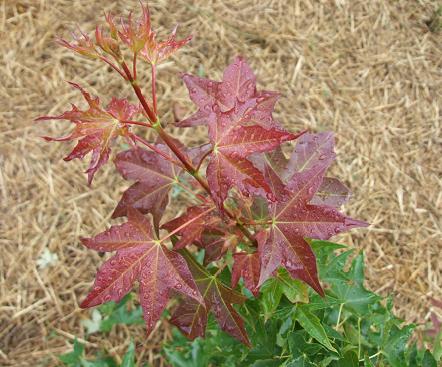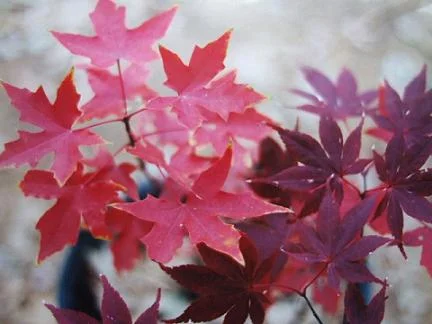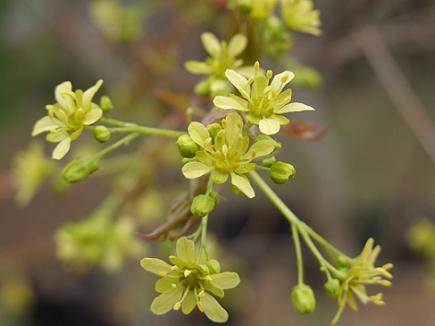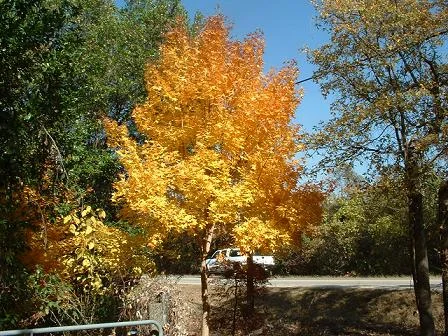
Fire Dragon
The first cultivar of a Shantung maple is called Fire Dragon� Maple and was discovered and introduced by Metro Maples. A medium-sized shade tree that only grows to 25-35 feet after many years and can take the hot Texas sun. Regular Shantung are also great maples that are very similar and explained below.
Fire Dragon� is the most consistent and reddest Shantung maple (and perhaps the reddest fall color of any maple) that I have ever seen, and was selected from among the twenty-three thousand seedlings I have grown. It also has a near perfect leaf shape that makes a more elegant and cleaner looking tree.
Shantung maples are in high demand and are gaining popularity in 49 states. This tree will prove to be tougher and just as beautiful as any maple growing in the northeast US. Hardy and heat tolerant, it will grow just about anywhere in acidic or alkaline soils. Over 6,000 Fire Dragons sold since the 2006 introduction!
In 2008 in Tokyo, Keith Johansson met a Chinese botanist, professor and author and had him pronounce Shantung. He pronounced it Shan-doon. The second syllable rhymes with moon and is slightly higher in pitch.

'Fire Dragon'
(PP #17367) because of its superior fall color and great leaf shape. It's full name is: Acer truncatum 'Fire Dragon�'.
This is a close-up photo of a 'Fire Dragon' leaf in fall color.
METRO MAPLES INTRODUCTION - FIRE DRAGON� MAPLE, PP #17367.
THREE HUGE FACTS:
1. 3 days of freezing temperatures, each down to 24 degrees and not above freezing in NW Arkansas, in mid-April, did ZERO damage to 'Fire Dragon', but defoliated all the oaks and other maples.
2. 2011 was the hottest, driest, windiest, worst Texas summer of all time and yet9 for 9 'Fire Dragons'� survived and colored up normally in the fall without irrigation in my dry sandy soil.
3. Shantung maples were top performers with the least damage from severe ice storms in Oklahoma.

Contrasting Shantungs in Fall Color
'Fire Dragon' Shantung in the foreground, and a regular Shantung with yellow fall color in the background.
Shantung are hardy to zone 4, and have not been damaged by ice or from temperatures 25 degrees below zero!
Shantung have a fibrous root system which is not overly aggressive, and grows easily even in alkaline clay soils.

Spring Color on 'Fire Dragon'
Close-up of spring color on Fire Dragon. The new growth emerges a red-orange in summer.
Most Shantung maples have a reddish-purple spring color and are sometimes referred to as 'Purple Blow' maple. Fire Dragon maple has five very uniform toothed-lobes and the look is more elegant than regular Shantung.
Planting tip: The best time to plant is mid-September through early March.

Hundreds of young 'Fire Dragon' grafts with late spring color in 2005 turning from burnt orange to a orange-pink.
Shantung maples grow 2 to 5 feet per year.
This tree has a superior root system with no faults except it cannot tolerate water-logged soils. Other superior traits are bright yellow blooms, majestic spreading shape, interesting bark, and disease resisance.

This is the early summer rose-red color on 'Fire Dragon' maple.
The new growth colors are from pigments that might help protect the new leaves from ultra-violet rays or from insects, until the leaf has a chance to photosynthesize or produce tannins to ward-off insects. Spring colors are awesome in cool weather.

Summer growth on 'Fire Dragon' maple. It can also be a brighter red or a burnt orange.


September thru November in 2007 was the second hottest fall ever recorded in the D/FW area, yet 'Fire Dragon' maples colored-up like this on December 2.
'Fire Dragon' reliably turns red from Oregon, New York, Virginia, to Arkansas and Oklahoma, and even all the way down to Houston.

Finding a consistent red for hot, sunny climates has never been achieved until now. Here is 'Fire Dragon' Shantung in the fall of 2007 contrasting with the bright yellow fall color of Ginkgo 'Autumn Gold'.
Most shade trees that turn red in the northern parts of the USA never produce red in Texas. Do not confuse a Shantung with Sugar maple, Red, Silver or any other maple you have heard about. This maple is totally different and you'llbe amazed at its beauty and toughness.

In 2009 we saw a new fall color for 'Fire Dragon'. After 27 inches of rain in just the last 10 weeks, and endless clouds, and the first actual fall feeling temperatures in many years, some turned a brilliant orange, before turning red!

This is the top of a 65-gallon 'Fire Dragon' maple with red color in 30mph winds.
There are at least 3 different red anthocyanin compounds that can form in the fall based mostly on temperatures and length of chilling, and soil pH does not seem to affect the color. I have seen bright cardinal red, currant red with Chinese yellow margins, and reddish-orange, but never yellow unless it turns fall color early due to stress.
Fall colors are consistent on every branch and leaf, and color is not much affected by clouds or shade or high/low temperatures or soil pH.

The attractive branching and bark of a Shantung maple. Three year old wood is very hard. One of the least damaged from ice storms, according to Kansas State and Oklahoma State University studies.
Shantung maples grow in full sun in all soils except very water-logged soils. They can take the Texas heat or Minnesota cold, and are very drought tolerant.
They also adapt well to shade, and can survive there for many years until they reach the sunlight.

Close-up of Shantung bark at the root flare on a 12 year old tree grown with very little irrigation or fertilizers.
Tip: Although the wood is very hard the beautiful bark is soft and can be scratched or bruised.

A dark, glossy-green summer color. To me when they shine in the sun they look like green diamonds. Shantung maples have a very efficient root system that is not aggressive, a waxy and thick leaf, and low transpiration rates to help them through hot summers.
Shantung maples might grow to 35 feet tall and wide with age in the lower midwest. They grow faster and get a little bigger in warm climates than those grown farther north.
They are hardy to at least 25 degrees below zero. Shantung were one of the very few trees that had no damage from the huge late freeze in April 2007 across the midwest to North Carolina that destroyed 2 to 3 years worth of tree crops.

Large Shantung are not messy and will drop all leaves and cover the ground with color. They are easy clean-up compared to other trees and decompose quickly. Here are regular and 'Fire Dragon' leaves after leaf drop.
Acer truncatum has been used as a street tree in Shanghai for many years, tolerating the pollution, limited root space, and compacted soils. In the difficult DF/W climate you should give your Shantung plenty of room for the roots to grow to give it the best chance of survival long-term.
In its native habitat, Shantung maples are expected to live 250 years or more.

'Fire Dragon' Shantung maple in fall 2006 on the right with a regular Shantung, left.
Named after the revered symbol of its home country, China, the Dragon is considered a benevolent creature that brings rain!

Spring Blooms
Mother 'Fire Dragon' Shantung maple with awesome yellow blooms in late March 2014.

Here is a picture of an Acer truncatum, Shantung Maple that Keith Johansson photographed at the Morris Arboretum, PA. It is a beautiful tree, grown with its natural low trunk shape. It was at the Arboretum at least by 1916 but probably there in 1906, making it 100 years old when he took this picture.
Somewhere in its history a low branch was removed from the right-hand side to allow clear passage on the road. Pictures taken from the left side did not reveal branching, only foliage.
The tree was 35 foot tall and 35 foot wide. Main branching occurred at 2 feet. Trunk diameter is about 2 1/2 feet. No surface roots or decay were observed.

In 2011 after the 4th International Maple Symposium in Belgium, Keith traveled to Kew Gardens in London and photographed this Acer truncatum. Most likely this is the tree in Maples of the World that stated was the first A. truncatum out of China and went to Kew in 1871, making this tree 140 years old.
The top of the first branch crotch is 6 foot off the ground! Estimated height and width is 38 x 50 feet. The trunk at ground level was 3 feet thick.

Here is a variegated Acer truncatum that Keith found. Keith has many other test plants and hopes to introduce more cultivars soon.

The early spring blooms are bright and very nice on Shantung maples and this picture does not do it justice. Most observed flowers are male flowers so 'volunteer' seedlings have not been an issue.
When you compare a Shantung maple to other shade trees it will always come out on top. It takes the heat, cold, wind, ice, bad soils, doesn't get too big, doesn't have surface roots, is long-lived, nice blooms, nice looking bark, nice leaf, doesn't produce many seeds, and has brilliant fall colors.

A close-up of a Shantung maple's half-opened cluster of small flowers.

A Shantung maple seedling in fall color. This beautiful tree has been grown with its natural shape and is in my display garden. The shape of a Shantung maple can be affected by its location but will eventually become rounded when given the room to spread.

Here is a close-up of a regular seedling-grown Shantung maple. It is as good a yellow as it gets. Some years a mix of oranges and reds combine with the yellow.

Shantung in glorious fall color at the entrance to Metro Maples. We have the largest Shantung maples in the DF/W area to look at.

This is the same tree as above only 7 years later.

Same as above without cloud cover and from the front side.

Metro Maples - Shantung Maple Cultivars:
Fire Dragon� Shantung maple (top left). Sales started in fall 2006.
Golden Dragon (top right). Sales started in fall 2009.
Skinny Dragon (bottom right). Sales started in fall 2009.
Witch's Dragon (bottom left). Not yet for sale.
Baby Dragon (center). Sales started in fall 2011.
This is the picture used in The Maple Society Article, Summer 2006, see below.

2010 was very dry and windy, then I had several record highs and 40+mph south winds in mid-November just as the Shantung began to color. These 2 Fire Dragons� managed to produce very nice color on November 22.
They were red-red in Oklahoma, Arkansas, and in Oregon where the weather was cooler, but generally orange-red this year in Texas.

WARNING: There are several garden centers and especially home improvement garden centers that are selling inferior maples that are labeled as Shantung maples.
The two top left leaves are Shantung maples. The top right is a Norway maple that had a Shantung tag. The lower left leaf is probably a sugar maple that had a Shantung tag.
Neither the Norway or Sugar maple are good trees for alkaline soils and will grow for only a short while and will not produce much fall color.
Both the Norway and Sugar maple have smooth gray bark, whereas even a small Shantung will show some fissured bar.

In 2011 this 'Fire Dragon', along with our other non-irrigated 'Fire Dragons' colored up after the hottest summer ever when many native trees perished in the heat.

Here is our founder, Keith Johansson, 'King of the Shantung'. (Current number of Shantung I have personally grown over 21 years: 33,411)
This Shantung (ten years old as shown) was grown from seed in 1995 and planted in the year 2000 as a test. It proved to be drought tolerant through that record-breaking hot and dry summer without irrigation (110 consecutive days without rain), even though it was planted in the dryest possible place, the top of a pure sugar-sand hill.
Texas A&M has designated the Shantung maple a Texas Superstar. Kansas State University has performed trials and declared it one of the best ornamental urban trees. The United States Department of Agriculture is currently researching Shantung maples and my Fire Dragon� Shantung to introduce tough, reliable, and beautiful trees that will not out-grow small urban yards. Oklahoma, Missouri, Utah and Minnesota and others have given their approval. Nobody has ever rejected this species as unsuitable. The future looks very bright for Shantung maples.

































